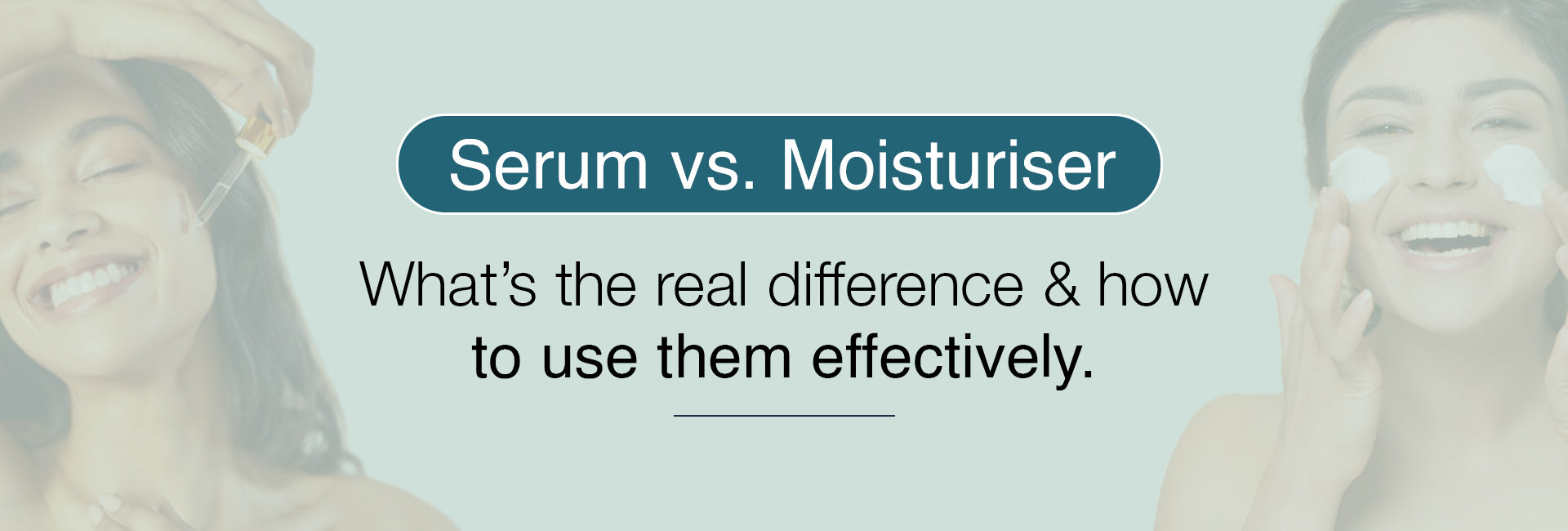Serum vs. Moisturiser: What’s the Real Difference and How to Use Them Effectively
In the world of skincare, the terms "serum" and "moisturiser" often get thrown around interchangeably, leading to confusion about their distinct roles. Understanding the difference between these two products is essential for achieving your best skin, especially when using high-quality formulations like those offered by Volvet Vogue. Let’s break down what each product does, how they work together, and why you should include both in your skincare routine.
Understanding the Basics
What is a Serum?
Definition and Purpose
A serum is a concentrated skincare product that contains active ingredients designed to penetrate deeply into the skin. These ingredients can address specific skin concerns, such as:
- Fine Lines and Wrinkles: Serums often contain anti-Ageing components like retinol or peptides.
- Hyperpigmentation: Vitamin C and other brightening agents can help reduce dark spots.
- Hydration: Hyaluronic acid and other humectants provide moisture at a deeper
Key Characteristics
- Texture: Serums typically have a lightweight, gel-like consistency that allows for quick absorption.
- Concentration: Serums are formulated with a higher concentration of active ingredients than moisturiser.s.
- Application: They are usually applied after cleansing and toning, before moisturiser., to allow the active ingredients to work effectively.
Volvet Vogue’s Serum Offerings
At Volvet Vogue, our serums are crafted with potent ingredients to target specific skin concerns. Whether you’re looking for anti-Ageing benefits or hydration, our range has something for everyone.
What is a moisturiser.?
Definition and Purpose
A moisturiser. is designed to hydrate and lock moisture into the skin. It serves as a protective barrier that prevents water loss, making it essential for maintaining skin health. moisturisers help:
- Hydrate: Keep the skin hydrated throughout the day.
- Protect: Form a barrier against environmental stressors.
- Smooth: Improve skin texture and appearance by providing a softer surface.
Key Characteristics
- Texture:s can be creamy or lotion-like, often thicker than serums to create a protective layer on the skin.
- Ingredients: They may contain emollients, occlusives, and humectants to provide various levels of hydration.
- Application:s are typically applied after serums to seal in the benefits of the active ingredients.
Volvet Vogue’s moisturiser. Offerings
Volvet Vogue offers a range of moisturiser.s tailored to different skin types and concerns. Our formulations prioritise hydration and protection, ensuring your skin remains healthy and radiant.
Key Differences Between Serum and moisturiser.
|
Aspect |
Serum |
moisturiser. |
|
Function |
Targets specific concerns (wrinkles, acne, brightening) |
Provides hydration and maintains skin barrier |
|
Texture |
Lightweight, thin, liquid or gel-like |
Thicker, ranging from lotions to creams |
|
Consistency |
Water-based or oil-based, absorbs quickly |
Sits on skin surface, absorbs slowly |
|
Active Ingredients |
High concentration of vitamins (A, C, E), peptides, antioxidants |
Emollients and humectants (glycerin, ceramides, hyaluronic acid) |
|
Penetration Depth |
Deep penetration, reaches epidermis and sometimes dermis |
Stays on surface, creates a moisture barrier on the epidermis |
|
Residue |
Non-greasy, quick absorption |
Thicker layer, provides long-lasting hydration |
How to Use Serums and moisturisers Together
To achieve optimal results from your skincare routine, it’s essential to use both serums and moisturiser.s correctly:
- Cleanse Your Skin: Start with a gentle cleanser to remove impurities.
- Apply Toner (Optional): If you use a toner, apply it next to balance your skin’s pH.
- Use Serum: Take a few drops of your chosen serum and gently massage it into your skin. Focus on areas of concern, allowing it to absorb completely.
- Apply moisturiser: Follow up with a moisturiser. to lock in the serum’s benefits and provide hydration.
- Sunscreen (Daytime): Finish your morning routine with sunscreen to protect your skin from UV damage.
Common Mistakes to Avoid
- Skipping One for the Other
Many people believe they can skip the moisturiser. if they’re using a serum (or vice versa), but this isn’t true. Both products serve different purposes, and you need both for a complete skincare routine. Skipping one can lead to imbalanced skin. For example:
- If you use serum without moisturiser., your skin might dry out because the serum doesn’t provide long-lasting hydration.
● If you use moisturiser. without serum, you may miss out on the targeted benefits that serums offer.
2. Not Layering Properly
It’s essential to apply serum before moisturiser., as serums are lightweight and need to penetrate deeper into the skin. moisturisers are thicker and should be applied on top to lock in hydration and create a protective barrier.
3. Overloading on Active Ingredients
Be cautious when combining multiple serums or moisturisers containing potent ingredients. Too many active ingredients, like retinol or vitamin C, can lead to irritation. Start with one serum and one moisturiser., and slowly introduce new products to see how your skin responds.
Preventing Common Skin Issues with Serum and moisturiser.
Using both a serum and a moisturiser. can help prevent many common skin issues:
● Dryness and Dehydration: A moisturiser. ensures your skin stays hydrated throughout the day, while serums with ingredients like hyaluronic acid can boost your skin’s moisture levels.
● Premature Ageing: Serums with ingredients like retinol and vitamin C target fine lines and wrinkles, while moisturisers with antioxidants can protect your skin from environmental stressors that cause ageing.
● Breakouts and Acne: If you’re prone to breakouts, using a serum with salicylic acid or niacinamide can target acne without clogging your pores. A lightweight, non-comedogenic moisturiser. will hydrate your skin without contributing to breakouts.
● Hyperpigmentation and Dark Spots: Serums containing vitamin C or niacinamide can help fade dark spots and even out your skin tone, while moisturiser.s with added sunscreen can prevent further pigmentation caused by sun exposure.
Conclusion
Understanding the difference between serums and moisturisers is crucial for creating an effective skincare routine. Both products serve unique purposes that can enhance your skin’s appearance and health when used correctly. At Volvet Vogue, we emphasise the importance of quality formulations that deliver results.
By incorporating both serums and moisturisers into your daily regimen, you can target specific skin concerns while maintaining optimal hydration. Explore our range of Volvet Vogue products to find the perfect serum and moisturiser. combination for your skincare needs, and unlock the radiant, healthy skin you deserve!






Share:
5 Best Natural Tips For Skin Care
Top 10 Skincare Mistakes You Didn't Know You Were Making